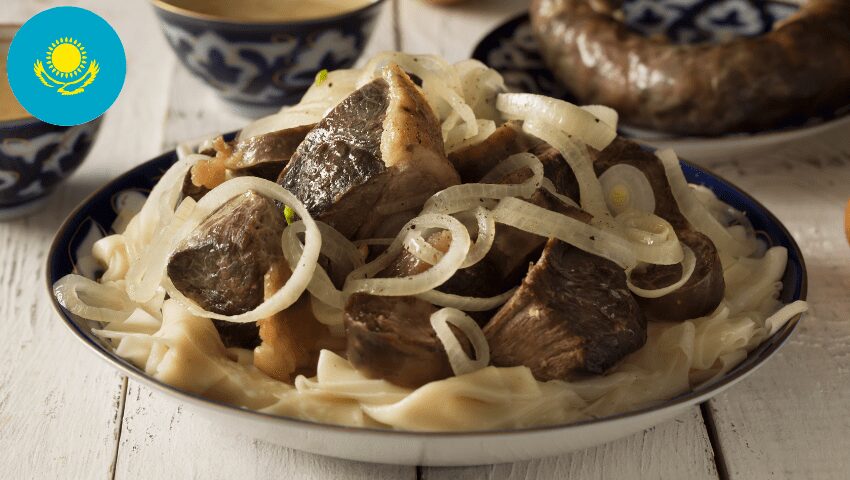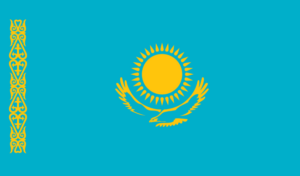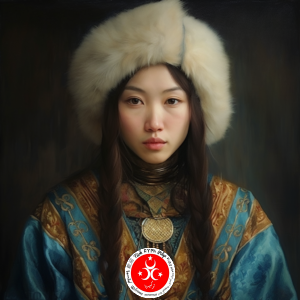Table of Contents
This article contains everything you need to know about the most popular foods in Kazakhstan. The Kazakh national cuisine is a centuries-old culinary tradition. The nomads’ daily diet is extremely beneficial to health and exemplifies Kazakh hospitality and variety.
The transition from winter to spring and much more determines the culinary menu, the technologies of its preparation (drying, salting, steaming, frying) (drying, salting, steaming, frying). After a long winter, certain foods are specially prepared for spring and fall. Read on to learn more about these delicious Kazakh dishes.
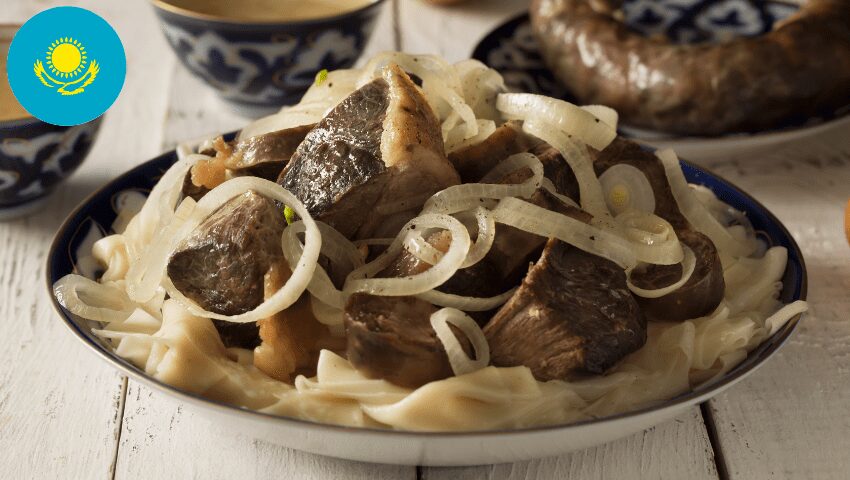
About Kazakh Cuisin
When you think of Kazakh cuisine, the first thing that comes to mind is meat. Meat food is very important in the development of the Kazakh people. Because of nomadic animal husbandry, meat accounts for 80 percent of the Kazakh menu, with grain crops accounting for the remainder due to well-developed agriculture in the southern regions. Kazakhs cooked with mutton and horse meat; beef was rarely used because the cow was not well adapted to nomadic life. Poultry meat is also used infrequently. Horse meat is the main course because it has unique nutritional properties.
Most Popular Foods in Kazakhstan
1. Kurt
Kurt is a fermented, hardened cheese ball that is emblematic of nomadic Kazakh cuisine. It is one of the many fermented dairy products that Central Asian nomads have been producing since the Middle Ages in order to create a durable source of sustenance.
Before drying in the sun, sheep, mare, cow, goat, or camel milk is strained into soft curds and formed into small balls or disks. This produces a portable, high-calcium snack that can withstand multiple seasons and long journeys.
2. Shubat
It is a fermented camel’s milk beverage. It’s a Turkish beverage popular throughout Central Asia, particularly in Turkmenistan (chal) and Kazakhstan, where it’s a staple summer drink.
Pour fresh camel milk and a starter into a leather wine bag or a ceramic jar to make it. It is left to ferment for a few days, after which the soured milk is stirred gently until it gets thick and smooth.
3. Kumis
Kumis (also spelled koumiss or kumys) is a popular fermented mare’s milk drink in Kazakhstan. It has provided Turkish and Mongol nomads with refreshment and sustenance for countless centuries.
There is an abundance of sugar and lactose in mare’s milk. It has a strong laxative effect when consumed fresh, but its high sugar content makes it easy to ferment. Fresh mare’s milk was stored in vats until it became acidified and produced carbonated alcohol. Nomads would then transport the liquid in leather bags, punching it occasionally to keep the kumis agitated.
Kumis has historically been an important cultural beverage for Central Asian nomads. At the beginning and end of each milking season, it was customary for nomads to invite family and friends for kumis. They exchanged blessings and well wishes while sharing the first and last kumis of the season.
As with shubat, kumis is well-known for its many health benefits. It is beneficial to the digestive and nervous systems and is believed to prevent tuberculosis. Even mothers would give their infants a version of kumis that was low in alcohol but not alcohol-free.
The alcohol content of kumis used to be higher, but modern versions contain only about 2% alcohol. In urban areas, kumis are typically made with fortified cow’s milk, whereas in rural areas, mare’s milk is still used.
4. Shalap
Shalap is a fermented drink made from water, salt, and either yogurt (qatiq) or kurt. Traditionally, plain water was used to make shalap, but carbonated water is frequently used in modern preparations.
Shalap is also widely consumed in Kyrgyzstan and Uzbekistan (chalap) (chalob). It can occasionally be made with herbs, giving it the appearance of a cold soup, although this is uncommon. As with shubat, this popular and refreshing summer beverage has been described as being pleasingly salty, sour, and smokey. Some westerners may acquire a taste for it over time.
5. Tandyr Nan
Tandyr nan is a popular type of bread in Kazakhstan and other Central Asian nations. It is essentially a tandyr-baked Central Asian version of naan bread (tandoor). It is known by a variety of names, including tandir non, tonur non, patyr nan, and lepyoshka, depending on its origin and method of preparation.
Tandyr nan, which is roughly the size of a dinner plate, is characterized by its raised rim and indented center. It can be served plain, topped with a poached egg, or dusted with sesame or nigella seeds. Typically, plain or seeded varieties are consumed for breakfast, whereas heavier varieties are paired with salads and meat dishes for lunch and dinner. Kazakh restaurants may offer damdy nan, a smaller and more decorative version.
Also read: Dolma Recipe: A Delicious Turkish Food
6. Shelpek
Shelpek is a popular Central Asian flatbread throughout the region. Flour, milk, sour cream, butter, baking soda, sugar, and salt are combined to form the dough. The dough is shaped into balls and rolled into discs before being fried in hot vegetable oil until golden brown.
On Fridays, the holiest day of the week in Islam, Kazakhstan traditionally distributes seven or more shelpeks. They are given to friends and neighbors, left at mosques, or sanctified through the reading of the Koran. Numerous Turkish nationalities observe this practice of memorialization.
Also read: Golden Milk: 14 Important Benefits, Recipes, Side Effects
7. Baursak
Baursak (or boorsog) are puffy, fried pieces of Kazakh bread. They are essentially donuts from Central Asia made with flour, yeast, eggs, margarine, milk, water, sugar, salt, and vegetable oil. Typically served with tea and eaten as a dessert with sugar, honey, or butter, they are shaped as triangles or spheres and served with tea.
As delicious as they appear, baursak are not a typical Kazakh dish. It is typically reserved for special events such as weddings and funerals. According to legend, the aroma of frying oil and baursak rises to the heavens so that your deceased loved ones can enjoy them with you.
8. Manti
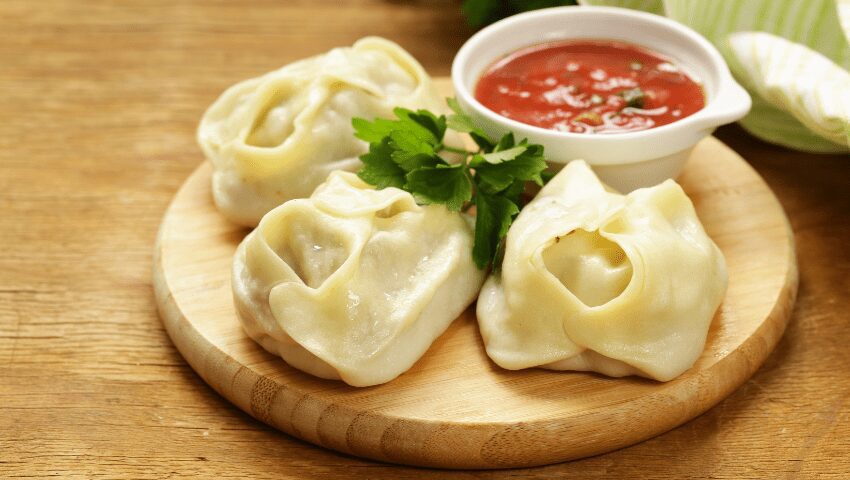
Manti is a popular type of dumpling in Turkish cuisine. It is well-liked in Central Asia, the South Caucasus, the Balkans, and other regions.
Manti vary in size and shape depending on the region, but they are typically made with a spiced meat mixture, typically ground lamb or beef, wrapped in thin dough, and boiled or steamed. They resemble the appearance of Mongolian buuz, Chinese baozi and jiaozi, Tibetan momo, and Korean mandu.
The exact origins of manti are unknown, but the most plausible theory is that it originated in the territories of the Mongol Empire. Others believe it originated in the Middle East, while others attribute it to the Uyghur people of northwest China.
Manti is typically stuffed with lamb mince in Kazakhstan and Kyrgyzstan, but it can also be stuffed with beef or horse meat. Typically, pumpkin or squash is combined with minced meat and seasoned with black pepper. It is typically sprinkled with hot red pepper powder and served with butter, sour cream, and an onion or garlic sauce when sold as street food.
9. Plov
Plov (or palau) is the Central Asian version of pilaf, a rice dish cooked in stock or broth with lamb, onions, and carrots, among other ingredients. Typically, it is prepared in a kazan as a family meal or when serving a large number of guests.
10. Kuurdak
Traditional Central Asian Kuurdak consists of roasted or fried meat, offal, onions, garlic, and potatoes. Originating in Kyrgyzstan, it is consumed widely throughout the region under a variety of names, including qyrdaq, gowurdak, qovurdoq, and qordaq.
Depending on its origin, kuurdak may be prepared with a variety of meats. In Kyrgyzstan, it is typically prepared with lamb or beef, whereas in Kazakhstan, sheep offal such as liver, heart, kidney, and lungs are typically used. Typically, it is prepared immediately after the sheep is slaughtered.
11. Beshbarmak
Kazakhstan’s national dish is beshbarmak. It consists of boiled meat, thin pasta sheets, and a sauce made of onions, beef broth, salt, and pepper. Horse and lamb are the most common meats, but beef can also be used.
Beshbarmak is one of the Kazakh foods that is most important to their culture. Even the manner in which it is served is regulated by ritual (ustukan). When an animal is slaughtered in honor of a guest, the various cuts of meat are served based on age, gender, and social standing. The elderly and distinguished guests are always served the finest cuts of meat.
For instance, the thigh bone (jambash) is given to the oldest men, whereas the tailbone is given to the oldest and most revered women (kuiruk or kuymulchak). The housewife reserves the smaller bones for her daughter-in-law. Children receive the animal’s spine, while adolescents receive the animal’s legs and shoulders (omurtka).
One of the best parts of the animal, the head (bash) is given to the guest of honor or the eldest or youngest male to cut and distribute to others. According to tradition, other animal parts, such as the shin bones, femur, and ribs, are also divided.
Beshbarmak is the national dish of Kazakhstan and Kyrgyzstan, as well as a regional favorite. It is also known as khorkhog, naryn, turama, dograma, and tullama. Beshbarmak literally translates to “five fingers,” alluding to the fact that nomadic people ate the dish with their hands.
12. Kazy
Kazy (or qazi) is a horse meat sausage popular in Central Asian nations including Kazakhstan, Kyrgyzstan, and Uzbekistan. Traditionally, it is made from the meat and fat of a creature’s ribs.
The horse’s ribs are hung for several hours with the meat still attached in order to prepare them. The meat is seasoned with garlic, pepper, and salt before being stuffed into the animal’s cleaned and salted intestines. The sausages are then either smoked for several hours or dried in direct sunlight and wind for one week.
Before serving, Kazy is boiled and cut into thin slices. It can be served cold as an appetizer or blended with other Kazakh dishes like beshbarabak.
